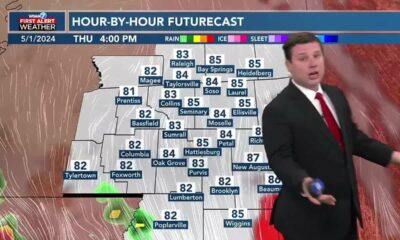Kaiser Health News
California Debates Extending PTSD Coverage to More First Responders
by Annie Sciacca
Tue, 09 May 2023 09:00:00 +0000
If you or someone you know may be experiencing a mental health crisis, contact the 988 Suicide & Crisis Lifeline by dialing “988,” or the Crisis Text Line by texting “HOME” to 741741.
A paramedic for about 30 years, Susan Farren knew all was not well with first responders: Eight of her colleagues had died by suicide. Others had grappled with substance abuse or gone through painful divorces.
So, in 2018, Farren founded a nonprofit in Santa Rosa to train and support emergency personnel struggling with trauma and stress. Hundreds of firefighters, police officers, and other first responders have since availed themselves of the organization's timely help.
“Nobody prepares you to walk into a house where four people have been murdered,” said Farren, executive director of First Responders Resiliency, Inc.
Firefighters, paramedics, and police often respond to the worst days of people's lives — accidents, deaths, fires, and other distressing events. After the deadly mass shootings earlier this year in Monterey Park and Half Moon Bay, and countless others across the country, awareness of how such trauma affects first responders has grown.
But there is no national consensus on when and which emergency personnel should be provided workers' compensation benefits.
“We wouldn't think twice about taking care of a first responder who broke their leg, and we shouldn't think twice about taking care of their mental health needs,” Karen Larsen, CEO of the Steinberg Institute, a nonprofit public policy institute, said in an email.
This year, there has been a push in California by first responders for laws that expand access to workers' compensation for post-traumatic stress injuries among their ranks. But some business groups and local governments want to pump the breaks, citing worries about potential fraud or abuse of the workers' compensation system.
The allegation that some people could take advantage of a more open workers' compensation system should not deter California from providing immediate access to mental health treatment to those who need it, said Farren, who noted that many of the first responders she works with are denied workers' compensation coverage or have to go through many steps to get it approved.
“That shouldn't keep us from getting help to those who really need it. That help should be available often, and affordably, and it should be available immediately,” Farren said.
Perceptions about employers' responsibility for alleviating work-related mental stress have changed over time, and that's showing up in workers' compensation. Each state has its own workers' compensation laws, which provide benefits like disability pay and medical care to workers injured or sickened on the job.
More than half have enacted PTSD policies or policy changes since 2018, according to a 2021 report by Optum, a company that creates workers' compensation programs. Coverage varies widely for post-traumatic stress injuries, which can be triggered by a single traumatic event or continued exposure to high stress and traumatic events.
In 2019, Gov. Gavin Newsom signed legislation into law to give California firefighters and police officers a stronger chance at earning workers' compensation. The bill, SB 542, authored by state Sen. Henry Stern (D-Calabasas) changed state law so that post-traumatic stress “injury,” such as PTSD, is legally presumed to be work-related for those first responders.
It was a small step by lawmakers in a state where recognition of work-related injuries for workers' compensation has typically been limited to physical illnesses such as heart disease and cancer. Previously, psychiatric conditions were handled differently, with employers and insurance companies long contending that psychological injuries can have many sources and might be too easy to blame on work.
Researchers at the Rand Corporation suggested in a 2021 report that further study is needed to evaluate the financial toll the 2019 law has had on employers — particularly counties and other municipalities that pay for police, firefighters, and other publicly employed first responders. Rand researchers estimated the added costs for local governments and the state to cover post-traumatic stress injuries could rise from $20 million to $116 million annually.
Firefighters and police in most cases now no longer have to prove that work was mostly responsible for their PTSD. But the law sunsets in 2025 and excludes many other first responders, including dispatchers, paramedics, and first responders at state hospitals.
This year, legislation by state Sen. John Laird (D-Santa Cruz), SB 623, co-sponsored by an advocacy group representing firefighters in the state — California Professional Firefighters — would extend PTSD workers' compensation coverage until 2032 and open it up to state firefighters, additional law enforcement officers, public safety dispatchers, and other emergency response communication employees who work for public agencies. The Senate Labor, Public Employment and Retirement Committee unanimously approved the bill in April, and it is awaiting a vote by the Senate Appropriations Committee.
Business groups and local governments — many of which opposed the 2019 law — are lobbying against more expansion. In letters to lawmakers, groups including the California Chamber of Commerce, California Coalition on Workers' Compensation, California Hospital Association, and California State Association of Counties warned that pending legislation could “open the door to abuse and fraud.”
“There is no evidence that workers are being inappropriately denied the care or benefits that they need,” Virginia Drake, a spokesperson for the California Coalition on Workers' Compensation, told KFF Health News. The group represents employers, cities and counties, insurance brokers, and government agencies on issues of workers' compensation.
Legislation that would extend benefits to more first responders would “put taxpayer funds at risk by tying the hands of public employers and forcing them to pay even the most questionable claims,” she added in a statement.
In addition, there does not seem to be consensus on which emergency personnel should get covered.
A measure by Assemblymember Freddie Rodriguez, a Democrat from Chino who worked as an emergency medical technician for three decades, has stalled. AB 597 would expand workers' compensation coverage to paramedics and emergency medical technicians, but it didn't get a hearing in the Assembly. Unions representing paramedics and EMTs in California did not return messages seeking comment.
“It's a very stressful job,” said Rodriguez, who told KFF Health News that two of his paramedic friends had died by suicide. “It affects people differently.”
Clearing a path to speedy mental health recovery, particularly after traumatic incidents, “should be automatic,” he added.
It's unclear if Newsom will back Laird's bill extending coverage for groups of emergency responders, amid a projected $22.5 billion deficit. A spokesperson for his office, Omar Rodriguez, said the governor typically does not comment on pending legislation and “will evaluate the bills on their own merits if they reach his desk.”
Last year, the Democratic governor vetoed similar legislation, saying in a statement that it would be premature to shift coverage of PTSD before any studies had been conducted on how the current law has worked for those who are covered.
Broadening coverage, Newsom wrote, “could set a dangerous precedent that has the potential to destabilize the workers' compensation system going forward.”
This article was produced by KFF Health News, which publishes California Healthline, an editorially independent service of the California Health Care Foundation.
KFF Health News is a national newsroom that produces in-depth journalism about health issues and is one of the core operating programs at KFF—an independent source of health policy research, polling, and journalism. Learn more about KFF.
USE OUR CONTENT
This story can be republished for free (details).
By: Annie Sciacca
Title: California Debates Extending PTSD Coverage to More First Responders
Sourced From: kffhealthnews.org/news/article/california-debates-extending-ptsd-coverage-first-responders/
Published Date: Tue, 09 May 2023 09:00:00 +0000
Did you miss our previous article…
https://www.biloxinewsevents.com/on-the-night-shift-with-a-sexual-assault-nurse-examiner/
Kaiser Health News
Robert F. Kennedy Jr. Is Wrong About a Ban on NIH Research About Mass Shootings
Louis Jacobson, PolitiFact
Thu, 02 May 2024 09:00:00 +0000
“Congress prohibits the NIH from researching the cause of mass shootings.”
Robert F. Kennedy Jr. in an April 21 post on X
The National Institutes of Health is the federal government's main agency for supporting medical research. Is it barred from researching mass shootings? That's what presidential candidate Robert F. Kennedy Jr. said recently.
Kennedy, whose statements about conspiracy theories earned him PolitiFact's 2023 “Lie of the Year,” is running as an independent third-party candidate against President Joe Biden, the presumptive Democratic candidate, and the presumptive Republican nominee, former President Donald Trump.
On April 21 on X, Kennedy flagged his recent interview with conservative commentator Glenn Beck, which touched on gun policy. Kennedy summarized his gun policy views in the post, writing, “The National Institutes of Health refuses to investigate the mystery; in fact, Congress prohibits the NIH from researching the cause of mass shootings. Under my administration, that rule ends — and our kids' safety becomes a top priority.”
But this information is outdated.
In 1996, Congress passed the “Dickey Amendment,” an appropriations bill provision that federal officials widely interpreted as barring federally funded research related to gun violence (though some observers say this was a misinterpretation). Congress in 2018 clarified that the provision didn't bar federally funded gun-related research, and funding for such efforts has been flowing since 2020.
Kennedy's campaign did not provide evidence to support his statement.
What Was the Dickey Amendment?
After criticizing some federally funded research papers on firearms in the mid-1990s, pro-gun advocates, including the National Rifle Association, lobbied to halt federal government funding for gun violence research.
In 1996, Congress approved appropriations bill language saying that “none of the funds made available for injury prevention and control at the Centers for Disease Control and Prevention may be used to advocate or promote gun control.” The language was named for one of its backers, Rep. Jay Dickey (R-Ark).
But the Dickey Amendment, as written, did not ban all gun-related research outright.
“Any honest research that was not rigged to produce results that helped promote gun control could be funded by CDC,” said Gary Kleck, a Florida State University criminologist. But CDC officials, experts said, interpreted the Dickey Amendment as banning all gun-related research funding.
This perception meant the amendment “had a chilling effect on funding for gun research,” said Allen Rostron, a University of Missouri-Kansas City law professor who has written about the amendment. Federal agencies “did not want to take a chance on funding research that might be seen as violating the restriction” and so “essentially were not funding research on gun violence.”
Also, the Dickey Amendment targeted only the CDC, not all other federal agencies. Congress expanded the restriction to cover NIH-funded research in 2011.
Although the Dickey Amendment didn't bar gun-related research, federal decision-makers acted as though it did by not pursuing such research.
Moving Past the Dickey Amendment
Over time, critics of the gun industry made an issue of the Dickey Amendment and gathered congressional support to clarify the amendment.
In 2018, lawmakers approved language that said the amendment wasn't a blanket ban on federally funded gun violence research. By 2020, federal research grants on firearms began to be issued again, starting with $25 million to be split between the CDC and NIH.
By now, the CDC and NIH are funding a “large portfolio” of firearm violence-related research, said Daniel Webster, a professor at the Johns Hopkins Bloomberg School of Public Health.
Also, the Justice Department's National Institute of Justice has funded the largest study of mass shootings to date, Webster said, and is seeking applications for studies of mass shootings.
Our Ruling
Kennedy said, “Congress prohibits the NIH from researching the cause of mass shootings.”
Although the Dickey Amendment, a provision of appropriations law supported by the gun industry, didn't prohibit all federally supported, gun-related research from 1996 to 2018, decision-makers acted as though it did.
However, in 2018, Congress clarified the provision's language. And since 2020, CDC, NIH, and other federal agencies have funded millions of dollars in gun-related research, including studies on mass shootings.
We rate Kennedy's statement False.
Our Sources
Robert F. Kennedy Jr. post on X, April 21, 2024
National Institutes of Health, “NIH Awards Additional Research and Training Grants to Support Firearm Injury and Mortality Prevention Science,” Sept. 20, 2023
National Institute of Justice, “Public Mass Shootings: Database Amasses Details of a Half Century of U.S. Mass Shootings with Firearms, Generating Psychosocial Histories,” Feb. 3, 2022
National Institute of Justice, “NIJ FY24 Research and Evaluation on Firearm Violence and Mass Shootings,” Feb. 5, 2024
Centers for Disease Control and Prevention, “Funded Research,” accessed April 22, 2024
American Psychological Association, “A Thaw in the Freeze on Federal Funding for Gun Violence and Injury Prevention Research,” April 1, 2021
Allen Rostron, “The Dickey Amendment on Federal Funding for Research on Gun Violence: A Legal Dissection” (American Journal of Public Health), July 2018
Email interview with Gary Kleck, a Florida State University criminologist, April 22, 2024
Email interview with Daniel W. Webster, professor at the Johns Hopkins Bloomberg School of Public Health, April 22, 2024
Email interview with Jaclyn Schildkraut, executive director of the Regional Gun Violence Research Consortium at the Rockefeller Institute of Government, April 22, 2024
Email interview with Mike Lawlor, University of New Haven criminologist, April 22, 2024
Email interview with Allen Rostron, University of Missouri-Kansas City law professor, April 22, 2024
KFF Health News is a national newsroom that produces in-depth journalism about health issues and is one of the core operating programs at KFF—an independent source of health policy research, polling, and journalism. Learn more about KFF.
USE OUR CONTENT
This story can be republished for free (details).
——————————
By: Louis Jacobson, PolitiFact
Title: Robert F. Kennedy Jr. Is Wrong About a Ban on NIH Research About Mass Shootings
Sourced From: kffhealthnews.org/news/article/fact-check-rfk-jr-wrong-nih-research-mass-shootings-gun-control-dickey-amendment/
Published Date: Thu, 02 May 2024 09:00:00 +0000
Did you miss our previous article…
https://www.biloxinewsevents.com/breaking-a-promise-california-deficit-could-halt-raises-for-disability-workers/
Kaiser Health News
‘Breaking a Promise’: California Deficit Could Halt Raises for Disability Workers
Vanessa G. Sánchez
Thu, 02 May 2024 09:00:00 +0000
SACRAMENTO, Calif. — Families of people with intellectual and developmental disabilities say Gov. Gavin Newsom is reneging on a scheduled raise for the workers who care for their loved ones, and advocates warn of potential lawsuits if disability services become harder to get.
Citing California's budget deficit, the Democratic governor wants to save around $613 million in state funds by delaying pay increases for a year for about 150,000 disability care workers. The state will forgo an additional $408 million in Medicaid reimbursements, reducing funding by over $1 billion.
Some lawmakers say this decision will increase staff turnover and vacancies, leaving thousands of children and adults with disabilities without critical services at home and in residential facilities. Disability advocates warn it could violate the Lanterman Act, California's landmark law that says the state must provide services and resources to people with disabilities and their families.
Newsom is “breaking a promise,” said Felisa Strickland, 60, who has been searching for more than a year for a day program for her 23-year-old daughter, Lily, who has autism and cerebral palsy. “It's creating a lot of physical and mental health problems for people, and it's a lot of undue stress on aging parent caregivers like myself.”
Disability care workers, known as direct support professionals, provide daily, hands-on caregiving to help children and adults with intellectual and developmental disabilities, such as autism, cerebral palsy, and epilepsy, remain independent and integrated into their communities.
In California, more than 400,000 people with disabilities need accommodation, and this population, along with seniors, is increasing. It's not clear how big the worker shortage is because the state hasn't released workforce data. As the demand for these workers grows generally, experts predict a shortage of between 600,000 and 3.2 million direct care workers by 2030.
Advocates say California pays most providers from $16 to $20 an hour, which meets the state's minimum wage but falls short of what some economists consider a living wage. In 2021, the state committed to raising wages after identifying a $1.8 billion gap between the rates received by nonprofits that contract with the state to provide care and the rates deemed adequate.
Thus far, the state has provided around half that total, most of which has gone to raising wages and benefits. Workers had been expecting one more increase, of $2-$4 an hour, in July, until Newsom proposed a delay.
Also, nonprofits say California has made it harder to compete for workers after raising wages in other service and health industries. Newsom approved a $20 minimum wage for fast-food workers that went into effect in April and he struck a deal last year with unions and hospitals to begin raising health care workers' wages to a minimum of $25 an hour.
Ricardo Zegri said Taco Bell would pay him more than the $19 an hour he makes as a disability care worker in a supervisory position.
“Every paycheck, it's a discussion at home about what bills we need to prioritize and whether it's time to start looking for work that pays more,” said Zegri, who works a second job as a musician in the San Francisco Bay Area.
Newsom wants to preserve key health initiatives, including the state expansion of Medi-Cal to low-income immigrants regardless of legal status, and CalAIM, an ambitious $12 billion experiment to transform Medi-Cal into both a health insurer and a social services provider. However, the rate delay for providing disability care is the largest savings in the Health and Human Services budget as Newsom and legislative leaders look to cuts, delays, and shifts in funding to close a deficit estimated between $38 billion and $73 billion.
Dozens of legislators from both parties are asking Newsom and legislative leaders to preserve the increase. Assembly member Stephanie Nguyen, a Democrat from Elk Grove, signed a letter supporting the raise. Although lawmakers are negotiating with the administration, she said reversing the decision to delay the pay boost is unlikely. Everybody “has to take a hit somewhere,” Nguyen said.
Krystyne McComb, a spokesperson for the Department of Developmental Services, said even though the state would lose federal matching funds this year, it would resume drawing funds when the state reinstates the plan in 2025.
The department did not respond to questions about how it plans to retain workers and fill vacancies.
Newsom's proposal risks a collapse of the disability service system, which would violate the Lanterman Act and make the state vulnerable to lawsuits, said Jordan Lindsey, executive director of the Arc of California, a statewide disability rights advocacy organization.
Families say the state has already fallen short on services they need. Strickland quit her job to care for Lily, the Santa Barbara mother said. “It's not reasonable to expect someone to care for somebody else 24 hours a day, seven days a week,” she said.
Lily graduated from high school and in 2022 completed a program that prepares youth with disabilities to transition into adult life. She had been looking forward to joining a day program to make new friends but has yet to find a spot. And due to a shortage of workers, Lily receives only four hours a week at home with a provider, who is paid around $16 an hour.
When Lily hangs out with the provider, her demeanor changes to the happy person she used to be, Strickland said.
“The system is already in crisis,” she said. “There are tons and tons of people that are sitting at home because there's nowhere for them to go.”
——————————
By: Vanessa G. Sánchez
Title: ‘Breaking a Promise': California Deficit Could Halt Raises for Disability Workers
Sourced From: kffhealthnews.org/news/article/california-disability-worker-pay-delay-deficit/
Published Date: Thu, 02 May 2024 09:00:00 +0000
Kaiser Health News
AC, Power Banks, Mini Fridges: Oregon Equips Medicaid Patients for Climate Change
Samantha Young
Wed, 01 May 2024 06:00:00 +0000
Oregon is shipping air conditioners, air purifiers, and power banks to some of its most vulnerable residents, a first-in-the-nation experiment to use Medicaid money to prevent the potentially deadly health effects of extreme heat, wildfire smoke, and other climate-related disasters.
The equipment, which started going out in March, expands a Biden administration strategy to move Medicaid beyond traditional medical care and into the realm of social services.
At least 20 states, including California, Massachusetts, and Washington, already direct billions of Medicaid dollars into programs such as helping homeless people get housing and preparing healthy meals for people with diabetes, according to KFF. Oregon is the first to use Medicaid money explicitly for climate-related costs, part of its five-year, $1.1 billion effort to address social needs, which also includes housing and nutrition benefits.
State and federal health officials hope to show that taxpayer money and lives can be saved when investments are made before disaster strikes.
“Climate change is a health care issue,” so helping Oregon's poorest and sickest residents prepare for potentially dangerous heat, drought, and other extreme weather makes sense, said Health and Human Services Secretary Xavier Becerra on a visit to Sacramento, California, in early April.
Becerra said the Biden administration wants states to experiment with how best to improve patient health, whether by keeping someone housed instead of homeless, or reducing their exposure to heat with an air conditioner.
But Medicaid's expansion into social services may duplicate existing housing and nutrition programs offered by other federal agencies, while some needy Americans can't get essential medical care, said Gary Alexander, director of the Medicaid and Health Safety Net Reform Initiative at the Paragon Health Institute.
“There are 600,000 or 700,000 intellectually disabled people in the United States waiting for Medicaid services. They're on a waitlist,” said Alexander, who oversaw state health agencies in Pennsylvania and Rhode Island. “Meanwhile Medicaid has money for housing and food and air conditioners for recipients. Seems to me that we should serve the intellectually disabled first before we get into all of these new areas.”
Scientists and public health officials say climate change poses a growing health risk. More frequent and intense floods, droughts, wildfires, extreme temperatures, and storms cause more deaths, cardiovascular disease from poor air quality, and other problems, according to the federal government's Fifth National Climate Assessment.
The mounting health effects disproportionately hit low-income Americans and people of color, who are often covered by Medicaid, the state-federal health insurance program for low-income people.
Most of the 102 Oregonians who died during the deadly heat dome that settled over the Pacific Northwest in 2021 “were elderly, isolated and living with low incomes,” according to a report by the Oregon Health Authority, which administers the state's Medicaid program, with about 1.4 million enrollees. The OHA's analysis of urgent care and emergency room use from May through September of 2021 and 2022 found that 60% of heat-related illness visits were from residents of areas with a median household income below $50,000.
“In the last 10-plus years, the amount of fires and smoke events and excessive heat events that we've had has shown the disproportionate impact of those events on those with lower incomes,” said Dave Baden, the OHA's deputy director for programs and policy.
And, because dangerously high temperatures aren't common in Oregon, many residents don't have air conditioning in their homes.
Traditionally, states hit by natural disasters and public health emergencies have asked the federal government for permission to spend Medicaid dollars on back-up power, air filters, and other equipment to help victims recover. But those requests came after the fact, following federal emergency declarations.
Oregon wants to be proactive and pay for equipment that will help an estimated 200,000 residents manage their health at home before extreme weather or climate-related disaster hits, Baden said. In addition to air conditioning units, the program will pay for mini fridges to keep medications cold, portable power supplies to run ventilators and other medical devices during outages, space heaters for winter, and air filters to improve air quality during wildfire season.
In March, the Oregon Health Plan, the state's Medicaid program, began asking health insurers to find patients who might need help coping with extreme weather. Recipients must meet federal guidelines that categorize them as “facing certain life transitions,” a stringent set of requirements that disqualify most enrollees. For example, a person with an underlying medical condition that could worsen during a heat wave, and who is also at risk for homelessness or has been released from prison in the past year, could receive an air conditioner. But someone with stable housing might not qualify.
“You could be in a housing complex, and your neighbor qualified for an air conditioner and you didn't,” Baden said.
At the offices of insurer AllCare Health in Grants Pass, Oregon, air conditioners, air filters, and mini fridges were piled in three rooms in mid-April, ready to be handed over to Medicaid patients. The health plan provided equipment to 19 households in March. The idea is to get the supplies into people's homes before the summer fire season engulfs the valley in smoke.
Health plans don't want to find themselves “fighting the masses” at Home Depot when the skies are already smoky or the heat is unbearable, said Josh Balloch, AllCare's vice president of health policy.
“We're competing against everybody else, and you can't find a fan on a hot day,” he said.
Oregon and some other states have already used Medicaid money to buy air conditioners, air purifiers, and other goods for enrollees, but not under the category of climate change. For example, California offers air purifiers to help asthma patients and New York just won federal approval to provide air conditioners to asthma patients.
Baden said Oregon health officials will evaluate whether sending air conditioners and other equipment to patients saves money by looking at their claim records in the coming years.
If Oregon can help enrollees avoid a costly trip to the doctor or the ER after extreme weather, other state Medicaid programs may ask the federal government if they can adopt the benefit. Many states haven't yet used Medicaid money for climate change because it affects people and regions differently, said Paul Shattuck, a senior fellow at Mathematica, a research organization that has surveyed state Medicaid directors on the issue.
“The health risks of climate change are everywhere, but the nature of risk exposure is completely different in every state,” Shattuck said. “It's been challenging for Medicaid to get momentum because each state is left to their own devices to figure out what to do.”
A California state lawmaker last year introduced legislation that would have required Medi-Cal, the state's Medicaid program, to add a climate benefit under its existing social services expansion. The program would have been similar to Oregon's, but AB 586, by Assembly member Lisa Calderon, died in the Assembly Appropriations Committee, which questioned in a staff analysis whether “climate change remediation supports can be defined as cost-effective.”
The cost savings are clear to Kaiser Permanente. After the 2021 heat wave, it sent air conditioners to 81 patients in Oregon and southwest Washington whose health conditions might get worse in extreme heat, said Catherine Potter, community health consultant at the health system. The following year, Kaiser Permanente estimated it had prevented $42,000 in heat-related ER visits and $400,000 in hospital admissions, she said.
“We didn't used to have extreme heat like this, and we do now,” said Potter, who has lived in the temperate Portland area for 30 years. “If we can prevent these adverse impacts, we should be preventing them especially for people that are going to be most affected.”
This article was produced by KFF Health News, which publishes California Healthline, an editorially independent service of the California Health Care Foundation.
——————————
By: Samantha Young
Title: AC, Power Banks, Mini Fridges: Oregon Equips Medicaid Patients for Climate Change
Sourced From: kffhealthnews.org/news/article/oregon-medicaid-patients-climate-benefits/
Published Date: Wed, 01 May 2024 06:00:00 +0000
Did you miss our previous article…
https://www.biloxinewsevents.com/who-overturns-dogma-on-airborne-disease-spread-the-cdc-might-not-act-on-it/
-
Local News7 days ago
Sister of Mississippi man who died after police pulled him from car rejects lawsuit settlement
-
Mississippi Today7 days ago
At Lake High School in Scott County, the Un-Team will never be forgotten
-
Mississippi Today4 days ago
On this day in 1951
-
Mississippi News5 days ago
One injured in Mississippi officer-involved shooting after chase
-
SuperTalk FM3 days ago
Festival merger in Leland sets up one major event for Mississippi Delta
-
Mississippi News2 days ago
Two women accused of shoplifting across southeast captured in Mississippi
-
SuperTalk FM3 days ago
PERS bill set to phase in employer rate increase heads to governor’s desk
-
Mississippi News7 days ago
Ridgeland man sentenced for molesting girl





































